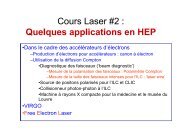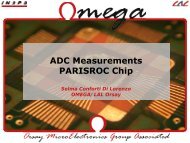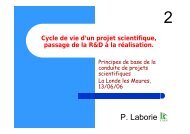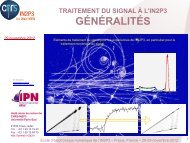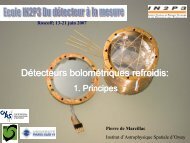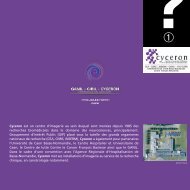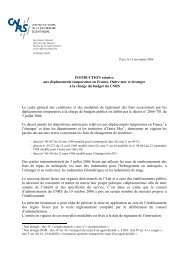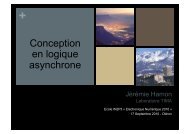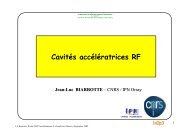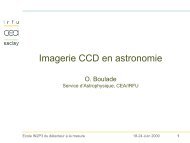SiPM - IN2P3
SiPM - IN2P3
SiPM - IN2P3
Create successful ePaper yourself
Turn your PDF publications into a flip-book with our unique Google optimized e-Paper software.
Nicoleta Dinu, Ecole microelectronique <strong>IN2P3</strong>, 24.06.2013<br />
Détecteurs <strong>SiPM</strong><br />
Nicoleta Dinu<br />
Laboratory of Linear Accelerator, Orsay<br />
Outline:<br />
• Introduction on solid-state photon detectors<br />
• <strong>SiPM</strong> physics and characteristics<br />
• <strong>SiPM</strong> applications<br />
1
Nicoleta Dinu, Ecole microelectronique <strong>IN2P3</strong>, 24.06.2013<br />
~ 4 µm<br />
Review of solid-state photon detectors<br />
PN or PIN<br />
APD<br />
GM-APD<br />
P + active area<br />
Depletion region<br />
P-N junction edge<br />
P + - Type<br />
N – Type Silicon<br />
high electric field<br />
multiplication region<br />
-epilayer<br />
p +<br />
n +<br />
e -<br />
h +<br />
N-Type Silicon<br />
p + -type silicon (substrate)<br />
p-n junction,<br />
reversed V bias – 0-3 V<br />
p-n junction,<br />
reversed V bias < V BD<br />
p-n junction,<br />
reversed V bias > V BD<br />
Gain = 1 Gain = M (~ 50-500)<br />
- linear mode operation-<br />
Gain → infinite<br />
-Geiger-mode operation-<br />
2
Nicoleta Dinu, Ecole microelectronique <strong>IN2P3</strong>, 24.06.2013<br />
Working regimes of reversed biased diodes<br />
Absolute reverse voltage<br />
Photodiode<br />
• 0 < V bias < V APD (few volts)<br />
• G = 1<br />
• Operate at high light level<br />
(few hundreds of photons)<br />
APD<br />
• V APD < V bias < V BD<br />
• G = M (50 - 500)<br />
• Linear-mode operation<br />
Absolute reverse voltage<br />
GM-APD or SPAD<br />
• V bias > V BD (V bias -V BD ~ few volts)<br />
• G <br />
• Geiger-mode operation<br />
• Can operate at single photon level<br />
3
Nicoleta Dinu, Ecole microelectronique <strong>IN2P3</strong>, 24.06.2013<br />
quenching<br />
Current (a.u.)<br />
Geiger-Mode Avalanche Photodiode<br />
The first single photon detectors operated in Geiger-mode<br />
R.H. Haitz<br />
J. Appl. Phys.,<br />
Vol. 36, No. 10 (1965) 3123<br />
J.R. McIntire<br />
IEEE Trans. Elec. Dev.<br />
ED-13 (1966) 164<br />
• Quenching mechanisms<br />
– Passive quenching: large resistance<br />
– Active quenching: analog circuits<br />
S. Cova & al., App. Opt. 35 (1996) 1956-1976<br />
Standard output signal<br />
Q = 10 5 -10 6 e<br />
Q Q Q<br />
Time (a.u.)<br />
-V bias<br />
Binary device<br />
• If one or more simultaneous photons fire the GM-APD,<br />
the output is anytime a standard signal: Q~C(V bias - V BD )<br />
• GM-APD does not give information on the light intensity<br />
4
Nicoleta Dinu, Ecole microelectronique <strong>IN2P3</strong>, 24.06.2013<br />
current<br />
S<br />
V BD<br />
R D<br />
Model of GM – APD & passive quenching<br />
DIODE<br />
C D<br />
R Q<br />
V BIAS<br />
I latch ~(V BIAS – V BD )/(R Q +R D )<br />
• OFF condition<br />
– No charge traversing the breakdown region<br />
– S – open<br />
– C D – charged to V BIAS > V BD<br />
– i ~ 0 through the circuit<br />
• ON condition<br />
– Avalanche discharge triggered by a carrier generated in<br />
the breakdown region (e.g. photon or thermal carrier)<br />
– S – closed<br />
– C D discharge to V BD with a time constant<br />
V<br />
V BIAS<br />
V BD<br />
t 0<br />
t 1 t 2<br />
time<br />
time<br />
discharge = R D * C D<br />
– Current through circuit increases asymptotically to<br />
I latch (V BIAS – V BD) /(R Q + R D )<br />
– Diode voltage decreases from V BIAS to V BD<br />
• OFF condition<br />
– S – open<br />
– C D – recharge again to V BIAS with a<br />
time constant R Q * C D (much longer than R D * C D )<br />
• ready for a new detection<br />
5
Nicoleta Dinu, Ecole microelectronique <strong>IN2P3</strong>, 24.06.2013<br />
What is a Silicon Photomultiplier (<strong>SiPM</strong>)?<br />
• matrix of n cells connected in parallel (e.g. few hundreds /mm 2 ) on a common Si substrate<br />
• each cell = GM-APD in series with R quench<br />
GM-APD<br />
V out<br />
R q<br />
Al grid line<br />
Al electrode<br />
V out<br />
Q tot = Q 1 +Q 2 =2Q<br />
1 pixel fired<br />
R q<br />
2 pixels fired<br />
Q 1 Q 2<br />
3 pixels fired<br />
GM-APD<br />
substrate<br />
V bias (-)<br />
V bias > V BD<br />
Key personalities in this development:<br />
V. Golovin, Z. Sadygov<br />
Quasi-analog device:<br />
• If simultaneously photons fires different cells,<br />
the output is the sum of the standard signals: Q~Q i<br />
• <strong>SiPM</strong> gives information on light intensity<br />
•Different producers give different names: <strong>SiPM</strong>, MRS-APD, SPM, MPPC…
Nicoleta Dinu, Ecole microelectronique <strong>IN2P3</strong>, 24.06.2013<br />
Silicon Photomultiplier (<strong>SiPM</strong>)<br />
Advantages<br />
high gain (10 5 -10 6 ) with low voltage (
Nicoleta Dinu, Ecole microelectronique <strong>IN2P3</strong>, 24.06.2013<br />
8
Nicoleta Dinu, Ecole microelectronique <strong>IN2P3</strong>, 24.06.2013<br />
<strong>SiPM</strong> today (just few examples)<br />
<strong>SiPM</strong>’s of small area<br />
Hamamatsu HPK<br />
S10362-11-025,050,100<br />
1 X 1 mm 2<br />
<strong>SiPM</strong>’s of large area<br />
ZEKOTEK<br />
MAPD-3N<br />
3 X 3 mm 2<br />
FBK - AdvanSiD<br />
ASD-<strong>SiPM</strong>4s<br />
4 X 4 mm 2<br />
Hamamatsu HPK<br />
S10985-50C<br />
4 X 4 mm 2<br />
KETEK<br />
PM3350<br />
3 X 3 mm 2<br />
STMicroelectronics<br />
SPM35AN<br />
3,5 X 3,5 mm 2
Nicoleta Dinu, Ecole microelectronique <strong>IN2P3</strong>, 24.06.2013<br />
Discrete <strong>SiPM</strong> arrays<br />
Producer Device ID Picture Total area<br />
(mm 2 )<br />
<strong>SiPM</strong> area<br />
(mm 2 /channel)<br />
Nr.<br />
channels<br />
cell size<br />
Hamamatsu<br />
S11064-025P<br />
S11064-050P<br />
18 x 16.2 3x3 16(4x4) ch 25x25 m<br />
50x50 m<br />
Hamamatsu<br />
C11206-0404DF 3x3 64(8x8) ch<br />
Hamamatsu<br />
S11834-3388DF 72x64.8 3x3 256(16x16)ch<br />
FBK<br />
AdvanSiD<br />
FBK<br />
AdvanSiD<br />
SensL<br />
ASD-<strong>SiPM</strong>4s-P-4x4T-<br />
50<br />
ASD-<strong>SiPM</strong>4s-P-4x4T-<br />
69<br />
8.2 x 8.2 4x4 16(4x4) ch 50x50 m<br />
69x69 m<br />
<strong>SiPM</strong> tile 32.7x32.7 4x4 64(8x8) ch<br />
ArraySM-4P9<br />
ArraySB-4P9 (blue<br />
sensitive)<br />
46.3 x 47.8 3x3 144(12x12) ch<br />
(based on<br />
monolithic<br />
Array SM4)<br />
35x35 m<br />
10
Nicoleta Dinu, Ecole microelectronique <strong>IN2P3</strong>, 24.06.2013<br />
Monolithic <strong>SiPM</strong> arrays<br />
Producer Device ID Picture Effective area<br />
(mm 2 )<br />
<strong>SiPM</strong><br />
area/channel<br />
(mm 2 )<br />
Nr. channels<br />
cell size<br />
Hamamatsu<br />
Hamamatsu<br />
S10984-025P<br />
S10984-050P<br />
S10984-100P<br />
S10985-025C<br />
S10985-050C<br />
S10985-100C<br />
1 x 4 1x1 4(1x4) ch 25x25 m<br />
50x50 m<br />
100 x 100 m<br />
6 x 6 3x3 4(2x2) ch 25x25 m<br />
50x50 m<br />
100 x 100 m<br />
Hamamatsu S11828-3344M 12 x 12 3x3 16(4x4) ch 50x50 m<br />
FBK<br />
AdvanSiD<br />
ASD-<strong>SiPM</strong>1.5s-P-<br />
8X8A<br />
11.6 x 11.6 1.45x1.45 64(8x8) ch 50x50 m<br />
FBK<br />
AdvanSiD<br />
ASD-<strong>SiPM</strong>3S-P-<br />
4X4A<br />
11.8 x 11.8 2.95x2.95 16(4x4) ch 50x50 m<br />
SensL<br />
Array SM-4<br />
Array SB-4 (blue<br />
sensitive)<br />
12 x 12 3x3 16(4x4) ch 35x35 m<br />
11
Nicoleta Dinu, Ecole microelectronique <strong>IN2P3</strong>, 24.06.2013<br />
12
Nicoleta Dinu, Ecole microelectronique <strong>IN2P3</strong>, 24.06.2013<br />
<strong>SiPM</strong> DC characteristics<br />
First test to verify the functionality of the device: breakdown voltage & overvoltage range<br />
MPPC 1mm 2<br />
50µm cell size<br />
T=25°C<br />
Working range defined by<br />
overvoltage: V=V bias -V bd<br />
V bd<br />
13
Nicoleta Dinu, Ecole microelectronique <strong>IN2P3</strong>, 24.06.2013<br />
<strong>SiPM</strong> reverse IV characteristics<br />
<strong>SiPM</strong>’s of 1x1 mm 2 with different technologies of 2007 productions<br />
N.Dinu&al, NIMA 610, 2009<br />
V bd range: 15-70V, based on device technology<br />
14
Nicoleta Dinu, Ecole microelectronique <strong>IN2P3</strong>, 24.06.2013<br />
<strong>SiPM</strong> forward IV characteristics<br />
<strong>SiPM</strong>’s of 1x1 mm 2 with different technologies of 2007 productions<br />
R cell = R measured /N cells<br />
~ hundreds of k: FBK, SensL, HPK<br />
N.Dinu&al, NIMA 610, 2009<br />
15
Nicoleta Dinu, Ecole microelectronique <strong>IN2P3</strong>, 24.06.2013<br />
Dynamic measurements in the dark<br />
V cc<br />
Keithley<br />
Multimeter 2000<br />
Keithley 2611<br />
V bias & PicoA<br />
<strong>SiPM</strong><br />
Pt100<br />
0.01-<br />
500MHz<br />
TDS 5054<br />
500MHz, 5GS/s<br />
boite métallique<br />
enceinte climatique ±0.1°C<br />
GPIB<br />
LabView<br />
Thanks to all team: V. Puill, V. Chaumat,<br />
J.F. Vagnucci & C. Sylvia, C. Cheikali<br />
16
Nicoleta Dinu, Ecole microelectronique <strong>IN2P3</strong>, 24.06.2013<br />
<strong>SiPM</strong>’s cell signal<br />
DIODE<br />
R Q<br />
S<br />
C V BIAS<br />
V D BD<br />
Read-out by a voltage amplifier (500 MHz, 50 , 45dB)<br />
on a scope (500 MHz)<br />
R D<br />
N.Dinu&al, NIMA 610, 2009<br />
• Measured signals characteristics<br />
• rise time: rise R D C D ~ 1-3 ns (read-out chain should be taken into account)<br />
• recovery time recovery R Q C D (influence the dead time and dynamic range):<br />
• ~ tens of ns for FBK, HPK devices; up to 200ns for SensL devices<br />
17
Nicoleta Dinu, Ecole microelectronique <strong>IN2P3</strong>, 24.06.2013<br />
<strong>SiPM</strong> cell gain & capacitance<br />
Defined as the charge developed in one cell by a primary charge carrier:<br />
Q<br />
Gain <br />
e<br />
cell<br />
<br />
C<br />
cell<br />
<br />
V<br />
e<br />
BIAS<br />
V<br />
BD<br />
<br />
<br />
C<br />
cell<br />
V<br />
e<br />
N. Dinu & al, NIM A 610 (2009) 423–426<br />
• G increases linearly with V bias at a given V BD<br />
• G: 5x10 5 – 5x10 6 simple or no amplifier required<br />
• The slope of the linear fit of G v.s. V cell diode capacitance<br />
• C pixel : tens to hundreds of fF<br />
• G and C pixel increase with the cell geometrical dimensions<br />
• C pixel ~ 0 r S/d; S - cell junction surface; d - cell depletion thickness<br />
18
Nicoleta Dinu, Ecole microelectronique <strong>IN2P3</strong>, 24.06.2013<br />
<strong>SiPM</strong> noise<br />
• Dark count rate<br />
• the main source of noise limiting the <strong>SiPM</strong> performances (e.g. single photon<br />
detection)<br />
• the number of false photon counts/s registered by the <strong>SiPM</strong> in the absence of the<br />
light<br />
• three main contributions:<br />
• thermal/tunneling – charge carriers generation by thermal/ trap-assisted tunneling<br />
phenomena – pulses looking the same as real photon pulses<br />
• afterpulses – carriers trapped during the avalanche discharging and then<br />
released triggering a new avalanche<br />
• optical cross-talk – photo-generation during avalanche discharge (hot carrier<br />
luminescence phenomena)<br />
– these photons can trigger an avalanche in an adjacent µcell<br />
19
Nicoleta Dinu, Ecole microelectronique <strong>IN2P3</strong>, 24.06.2013<br />
<strong>SiPM</strong> dark count rate<br />
DCR of single cell of<br />
40x40 µm 2 from FBK-irst<br />
DCR of different <strong>SiPM</strong>’s of 1x1 mm 2<br />
Piemonte & al., IEEE TNS, Vol. 54, Issue 1, 236-244<br />
N. Dinu & al, NIM A 610 (2009) 423–426<br />
• DCR – linear dependence due to triggering probability V<br />
- non-linear at high V due to cross-talk and after-pulses V 2<br />
• DCR scales with active surface<br />
• Critical issues:<br />
• Quality of epitaxial layer<br />
• Gettering techniques<br />
20
Nicoleta Dinu, Ecole microelectronique <strong>IN2P3</strong>, 24.06.2013<br />
21
Nicoleta Dinu, Ecole microelectronique <strong>IN2P3</strong>, 24.06.2013<br />
Light measurements – continuous or pulsed light<br />
Source halogène<br />
(100W)<br />
Monochromateur<br />
350-800nm<br />
Banc optique / boite noire<br />
CCD camera<br />
X<br />
Pt100<br />
Photodiode<br />
calibrée<br />
Keithley<br />
Multimeter 2000<br />
Keithley 2612<br />
V bias & PicoA<br />
GPIB<br />
Pilas laser diodes<br />
405, 470, 635 nm<br />
Laser diode driver<br />
Filtres<br />
neutre<br />
<strong>SiPM</strong><br />
Y<br />
Z<br />
table translation 3D<br />
(6 µm precision)<br />
TDS 5054<br />
500MHz, 5GS/s<br />
Pulse generator<br />
RS232<br />
LabView<br />
Thanks to all team: V. Puill, V. Chaumat, J.F. Vagnucci, C. Bazin<br />
• Continuous light: PDE vs (350-800nm):<br />
• low incident flux (~ 10 7 incident photons /s/mm 2 ) – to avoid the <strong>SiPM</strong> saturation<br />
• calibrated photodiodes (HPK S3590-18, UDT Instrument 221)<br />
• the number of the photons recorded by the <strong>SiPM</strong> – evaluated by two methods:<br />
• DC method & AC counting methods<br />
• Pulsed light: PDE, timing resolution, non-linearity<br />
• the number of the incident photons – evaluated with a PMT (HPK R614-00U)<br />
22
Nicoleta Dinu, Ecole microelectronique <strong>IN2P3</strong>, 24.06.2013<br />
Photon Detection Efficiency (1)<br />
PDE<br />
<br />
N<br />
N<br />
QE<br />
P<br />
output pulses incident<br />
photons<br />
01<br />
<br />
geom<br />
QE = Quantum Efficiency<br />
• probability for a photon to generate a carrier in the high<br />
field region<br />
b) Intrinsic quantum efficiency<br />
P 01 = Triggering probability<br />
• probability for a carrier traversing the high field to<br />
generate an avalanche<br />
geom = Geometrical fill factor<br />
• fraction of dead area due to structures between the pixels<br />
e.g. grid lines, trenches, R quench<br />
23
Nicoleta Dinu, Ecole microelectronique <strong>IN2P3</strong>, 24.06.2013<br />
PDE of different <strong>SiPM</strong>s<br />
• PDE of Photonique, FBK, SensL<br />
• PDE of HPK devices<br />
A. Vacheret & al, arXiv:1101.1996v1<br />
N. Dinu & al, NIM A 610 (2009) 423–426<br />
24
Nicoleta Dinu, Ecole microelectronique <strong>IN2P3</strong>, 24.06.2013<br />
<strong>SiPM</strong> jitter or timing resolution (1)<br />
Two components :<br />
• fast component of gaussian shape with σ O(100ps)<br />
• variation of generated carrier transit time from depletion region to<br />
multiplication region (longitudinal propagation: O(10ps))<br />
• statistical fluctuations of the avalanche build-up time (e.g. photon<br />
impact position cell size; transversal propagation: O(100ps))<br />
• slow component: minor non gaussian tail with time scale of O(ns)<br />
• due to minority carriers, photo-generated in the neutral regions<br />
beneath the depletion layer that reach the junction by diffusion<br />
(wavelength dependent)<br />
MePhI/Pulsar<br />
G. Collazol & al, NIM A, 581, (2007), 461-464<br />
Poisson<br />
statistics:<br />
σ ∝ 1/√Npe<br />
25
Nicoleta Dinu, Ecole microelectronique <strong>IN2P3</strong>, 24.06.2013<br />
<strong>SiPM</strong> jitter or timing resolution (2)<br />
SPTR – HPK devices<br />
SPTR – position dependence<br />
Detailed description of SPTR measurements and results:<br />
G. Collazuol,Pixel Workshop, FermiLab, 2008<br />
26
Nicoleta Dinu, Ecole microelectronique <strong>IN2P3</strong>, 24.06.2013<br />
recorded photons /s/mm^2<br />
Number of recorded pulses (includes DCR)<br />
<strong>SiPM</strong> response non-linearity<br />
The <strong>SiPM</strong> output signal is<br />
proportional to the number of<br />
fired pixels as long as the<br />
number of photons (N photon )<br />
times the photon detection<br />
efficiency PDE is smaller than<br />
the number of the pixels N total<br />
FBK device, 1x1 mm 2 , 625 cells; DCR = 1-2x10 6 Hz<br />
1.E+08<br />
1.E+07<br />
1.E+06<br />
1.E+05<br />
1.E+04<br />
N.Dinu, 2006, not published<br />
4.0V overvoltage: y = 0.1618x + 11199<br />
3.5V overvoltage: y = 0.1424x + 10332<br />
3.0V overvoltage: y = 0.1222x + 4809.3<br />
2.5V overvoltage: y = 0.1004x + 6517.6<br />
2.0V overvoltage: y = 0.0824x + 5054.3<br />
1.E+05 1.E+06 1.E+07 1.E+08 1.E+09<br />
incident photons /s/mm^2<br />
<br />
N <br />
firedcells Ntotal<br />
1 e<br />
<br />
<br />
N<br />
<br />
photon<br />
N<br />
PDE<br />
total<br />
Symplified model: Stoykov, & al., JINST June, 2007<br />
<br />
<br />
<br />
<br />
Main sources of non-linearity:<br />
• finite number of pixels - main contribution<br />
when N photons O(N cells )<br />
• finite recovery time<br />
• afterpulses, cross-talk<br />
• drop of V during the light pulse due to<br />
relevant signal current on external series<br />
resistance<br />
Detailed model to estimate non-linearity corrections: T. van Dam & al., IEEE TNS 57 (2010) 2254<br />
27
Nicoleta Dinu, Ecole microelectronique <strong>IN2P3</strong>, 24.06.2013<br />
28
Nicoleta Dinu, Ecole microelectronique <strong>IN2P3</strong>, 24.06.2013<br />
LAL set-up<br />
Thanks to all team: J.F. Vagnucci, C. Bazin, C. Cheikali, C. Sylvia, V. Puill, V. Chaumat,<br />
29
Nicoleta Dinu, Ecole microelectronique <strong>IN2P3</strong>, 24.06.2013<br />
Fermilab set-up<br />
Vertical column<br />
automatic filling with N 2<br />
System of<br />
N 2 flow control<br />
Cold finger<br />
Test vacuum cube<br />
<strong>SiPM</strong> locations<br />
Tubes connected to<br />
a vacuum pump<br />
Box: read-out electronics<br />
• T cryogenic control system Cryo.con + automatic flow control<br />
• Keithley 2400 for <strong>SiPM</strong> bias<br />
• CAEN digitizer – calibration (Vbd vs T)<br />
• Agilent Oscilloscope – waveforms acquisition @ dV=const<br />
Thanks to FermiLab team:<br />
Adam Para, Paul Rubinov, Kelly Hardin, Cary Kendziora, Carlos Ourivio Escobar<br />
30
Nicoleta Dinu, Ecole microelectronique <strong>IN2P3</strong>, 24.06.2013<br />
Zoom inside of cube<br />
Cold finger<br />
<strong>SiPM</strong><br />
in front of light<br />
<strong>SiPM</strong> in dark<br />
heater<br />
Pt100<br />
Optical fiber<br />
31
Nicoleta Dinu, Ecole microelectronique <strong>IN2P3</strong>, 24.06.2013<br />
Temperature dependence of <strong>SiPM</strong><br />
parameters<br />
- Few slides to be added<br />
32
Nicoleta Dinu, Ecole microelectronique <strong>IN2P3</strong>, 24.06.2013<br />
33
Nicoleta Dinu, Ecole microelectronique <strong>IN2P3</strong>, 24.06.2013<br />
• Calorimetry<br />
• Cherenkov<br />
• Medical<br />
• Number of applications still growing….<br />
Strengths<br />
• Flexible design<br />
• High gain<br />
• Compact<br />
• Fast<br />
• High PDE still growing<br />
• Insensitivity to magnetic fields<br />
• Low cost<br />
Weaknesses<br />
• High dark rate @ room temp.<br />
• afterpulses & cross-talk<br />
• Still “small” area<br />
• Temperature dependence of<br />
some parameters<br />
• Radiation damage<br />
34
Nicoleta Dinu, Ecole microelectronique <strong>IN2P3</strong>, 24.06.2013<br />
counts<br />
<strong>SiPM</strong> arrays & multichannels read-out electronics<br />
<strong>SiPM</strong> monolithic array of 4x4 channels from FBK-irst glued and wire bonded to a PCB @ Pisa<br />
Each channel: 1x1 mm 2<br />
625 cells, 40x40 µm 2 /cell<br />
• <strong>SiPM</strong> matrix (16 channels)<br />
• connected to MAROC2 chip (Omega Pole)<br />
4% uniformity<br />
N. Dinu & al, NIM A 610 (2009) 101–104<br />
<strong>SiPM</strong> monolithic array of 4x4 channels from Hamamatsu<br />
Each channel: 3x3 mm 2, 3600 cells, 50x50 µm 2 /cell<br />
I dark @ V=0.7V ~ 71±8nA<br />
V BD 71.4V<br />
Details on read-out electronics: see slides 40-42, SIPMED application<br />
Idark @ V bias = 72.3V 35
Nicoleta Dinu, Ecole microelectronique <strong>IN2P3</strong>, 24.06.2013<br />
<strong>SiPM</strong> @ medical applications<br />
Requirements<br />
• Compact & cheap<br />
• Fast TOF-PET<br />
• Insensitivity to magnetic field <br />
PET/MRI<br />
Applications<br />
• Innovative detector systems<br />
• Intra-operative probes, SPECT systems<br />
• PET: Time-of-flight PET, PET/MRI<br />
More details on PET applications: see G.Llosá, PhotoDet2012<br />
<strong>SiPM</strong> @ intra-operative probes - SIPMED<br />
• Aim of the project<br />
• Developement of a very compact intra-operative gamma probe based on<br />
arrays of <strong>SiPM</strong> coupled to scintillator and multi-channels read-out electronics<br />
• Teams<br />
• IMNC & LAL<br />
• Omega Pole<br />
• L’Hôpital Lariboisière<br />
36
Nicoleta Dinu, Ecole microelectronique <strong>IN2P3</strong>, 24.06.2013<br />
From POCI to SIPMED (1)<br />
POCI<br />
TreCam<br />
POCI<br />
TReCAM<br />
Spatial<br />
resolution<br />
3.2 mm<br />
(contact)<br />
1.8 mm<br />
(contact)<br />
Efficiency<br />
290<br />
cps/MBq<br />
300<br />
cps/MBq<br />
Energy<br />
resolution<br />
Active surface Dimension Weight<br />
32% 12.5 cm 2 h = 90 mm 1.2 kg<br />
95 mm<br />
11.3% 25 cm 2 h = 117 mm 2 kg<br />
140 x 83 mm 2<br />
37
Nicoleta Dinu, Ecole microelectronique <strong>IN2P3</strong>, 24.06.2013<br />
From POCI to SIPMED (2)<br />
<br />
collimator<br />
LaBr 3 (Ce) scintillator<br />
4x4 <strong>SiPM</strong> arrays (field of view: 25 cm 2 )<br />
1 array: 4x4 <strong>SiPM</strong>’s (13.6 x 13.7 mm 2 )<br />
1 readout channel = 1<strong>SiPM</strong> of 3x3 mm 2<br />
256 channels<br />
miniaturized readout electronics<br />
• SIPMED camera characteristics<br />
• Field of view 25 cm 2<br />
• Geometrical dimensions: 60x60x50 mm 2<br />
• Weight
Nicoleta Dinu, Ecole microelectronique <strong>IN2P3</strong>, 24.06.2013<br />
Characteristics of <strong>SiPM</strong> arrays<br />
39
Nicoleta Dinu, Ecole microelectronique <strong>IN2P3</strong>, 24.06.2013<br />
Elementary module SIPMED<br />
Carte 1 : matrices <strong>SiPM</strong><br />
Carte 2 : puces EASIROC<br />
(Pole Omega)<br />
Carte 3 : FPGA<br />
First electrical tests – very satisfactory<br />
Project under progress…..<br />
40
Nicoleta Dinu, Ecole microelectronique <strong>IN2P3</strong>, 24.06.2013<br />
<strong>SiPM</strong> @ calorimetry<br />
Requirements<br />
• Insensitivity to magnetic fields<br />
• Radiation hardness<br />
• Mass production with uniform<br />
properties and low cost<br />
Applications<br />
• Future applications (ILC, PANDA at Fair)<br />
• High granularity<br />
• Compactness, low weight (PEBS)<br />
• Upgrade of future experiments<br />
• Replacing current photo-detectors (CMS)<br />
• Increasing granularity<br />
<strong>SiPM</strong> @ ILC HCAL<br />
<strong>SiPM</strong>: tests with MePHI/PULSAR <strong>SiPM</strong> , HAMAMATSU MPPC<br />
<strong>SiPM</strong><br />
1 mm²<br />
PROTOTYPE<br />
216 tiles/layer (38 layers in total) ~8000 channels<br />
3 x 3 cm² plastic scintillator tile<br />
with embedded WLS fiber + <strong>SiPM</strong><br />
Readout of <strong>SiPM</strong>s by the<br />
SPIROC ASIC (Omega Pole)<br />
41
Nicoleta Dinu, Ecole microelectronique <strong>IN2P3</strong>, 24.06.2013<br />
42
Nicoleta Dinu, Ecole microelectronique <strong>IN2P3</strong>, 24.06.2013<br />
<strong>SiPM</strong> @ Tokai-to-Kamioka<br />
Neutrino oscillations studies<br />
ND280 : off axis neutrino beam flux and<br />
SuperK backgrounds measurements<br />
Two Fine Grain Detectors (FGDs):<br />
Total number of <strong>SiPM</strong>’s used @ T2K<br />
43
Nicoleta Dinu, Ecole microelectronique <strong>IN2P3</strong>, 24.06.2013<br />
Requirements<br />
<strong>SiPM</strong> @ Cherenkov detectors<br />
• Single photon detection<br />
• High PDE<br />
• Large area<br />
• Low dark count rate<br />
• Fast reponse<br />
Advantages with respect to PMT<br />
• Data analysis<br />
• Single photon resolution<br />
• High PDE<br />
• no known ageing<br />
• For the construction<br />
• No need high voltage (70 V vs kV)<br />
• More robust to light exposure<br />
FACT – First G-APD Cherenkov Telescope<br />
1440 <strong>SiPM</strong> + light collecting cones<br />
44
Nicoleta Dinu, Ecole microelectronique <strong>IN2P3</strong>, 24.06.2013<br />
45
Nicoleta Dinu, Ecole microelectronique <strong>IN2P3</strong>, 24.06.2013<br />
Additional slides<br />
46
Nicoleta Dinu, Ecole microelectronique <strong>IN2P3</strong>, 24.06.2013<br />
Avalanche triggering probability<br />
GM. Collazuol, IPRD08<br />
47
Nicoleta Dinu, Ecole microelectronique <strong>IN2P3</strong>, 24.06.2013<br />
Avalanche triggering probability<br />
48
Nicoleta Dinu, Ecole microelectronique <strong>IN2P3</strong>, 24.06.2013<br />
Radiation damage<br />
Radiation damage effects on <strong>SiPM</strong><br />
49
Nicoleta Dinu, Ecole microelectronique <strong>IN2P3</strong>, 24.06.2013<br />
Radiation damage: neutrons (0.1-1 MeV)<br />
50
Nicoleta Dinu, Ecole microelectronique <strong>IN2P3</strong>, 24.06.2013<br />
IRST – single photon timing resolution (SPTR)<br />
51
Nicoleta Dinu, Ecole microelectronique <strong>IN2P3</strong>, 24.06.2013<br />
HPK – single photon timing resolution<br />
52




